

Why we REALLY need protected bike lanes in the countryside. How Self-Driving Cars Can (and Should) Improve Transit. These "Power Lanes" Could Charge An E-Bike (And Phone) As You Ride. If electric bicycles could be charged just by riding on a powered bike lane, would more people want to use them?
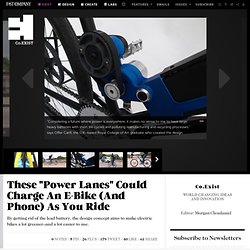
A new design concept for an e-bike shows how the system might work, eliminating one of the challenges of this type of transportation--the need for batteries. "Considering a future where power is everywhere, it makes no sense to me to have large, heavy batteries with short life cycles and polluting manufacturing and recycling processes," says Offer Canfi, the Royal College of Art graduate who created the design. Most of the world's electric bikes--especially the 30 million produced each year in China--still use lead batteries.
In China, lead production has caused mass poisonings, and recycling often causes even more problems when toxic wastewater is dumped in rivers. Though alternative batteries are becoming more common, they also have their own issues with manufacturing and disposal. How a bike can change your life. From paving roads to breaking racial and gender barriers, bikes have played a role in bringing people from all backgrounds together, as equals.

Today, Shifting Gears, a special show about the bicycle, airs CBC Radio One. Fallbrook Technologies Inc. How Bicycles Bring Business. Pat Brown was just hoping to hang on in a tough economy.
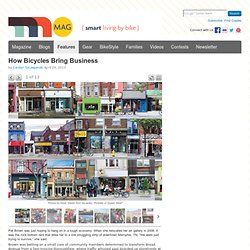
When she relocated her art gallery in 2008, it was the rock-bottom rent that drew her to a still struggling strip of downtown Memphis, TN. “We were just trying to survive,” she said. Brown was betting on a small core of community members determined to transform Broad Avenue from a fast-moving thoroughfare, where traffic whizzed past boarded-up storefronts at 50 mph (80 km/h), into a bustling arts district. Copenhagen wheel project. The Copenhagenize Index of Bicycle Friendly Cities. We don’t pay enough for transportation. In the United States, drivers (and parenthetically transit users … but this post is about drivers) don’t pay enough for transportation.

As a result, drivers use too much and have misleading anchors about what prices “should” be. When drivers are shown and charged the actual cost of things, they are surprised, and not a little bit disgruntled. An illustration: car2go vs. Private Costs of Auto Ownership. The Transportation Cost-Savings Calculator — Mobility Lab. APA-Planning-Magazine_Healthier-Commuting_July-2014.pdf. If an Electric Bike Is Ever Going to Hit It Big in the U.S., It's This One. CAMBRIDGE, Mass.
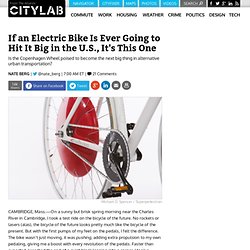
—On a sunny but brisk spring morning near the Charles River in Cambridge, I took a test ride on the bicycle of the future. The Future of Transportation. The Triumphant Return of Private U.S.
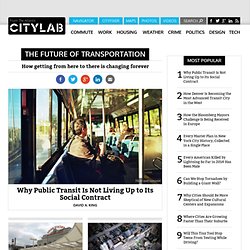
Passenger Rail Can new train service between Miami and Orlando be a model for the rest of the country? The Missing Link: Bicycle Infrastructure Networks and Ridership in 74 US Cities. Why do we need a buffer in Protected Bike Lanes? Well, here’s why…. Recently I had a quick exchange with a visiting cyclist who was pleasantly amazed at the "extra" space afforded bikes in most NYC protected bike lanes.
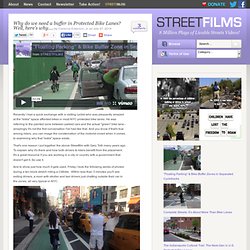
He was referring to the painted zone between parked cars and the actual "green" bike lane - amazingly it's not the first conversation I've had like that. And you know if that's true among riders, you can image the consternation of the motorist crowd when it comes to examining why that "extra" space exists. That's one reason I put together the above Streetfilm with Gary Toth many years ago. Is Canada missing the boat on cycling tourists?
Helsinki's ambitious plan to make car ownership pointless in 10 years. The Finnish capital has announced plans to transform its existing public transport network into a comprehensive, point-to-point "mobility on demand" system by 2025 – one that, in theory, would be so good nobody would have any reason to own a car.

Helsinki aims to transcend conventional public transport by allowing people to purchase mobility in real time, straight from their smartphones. The hope is to furnish riders with an array of options so cheap, flexible and well-coordinated that it becomes competitive with private car ownership not merely on cost, but on convenience and ease of use. Subscribers would specify an origin and a destination, and perhaps a few preferences.
The app would then function as both journey planner and universal payment platform, knitting everything from driverless cars and nimble little buses to shared bikes and ferries into a single, supple mesh of mobility. Socialcyclist. Five cities reveal 'Ultimate urban utility' bikes: How does Portland's entry compare? - BikePortland.org. The “Solid” bike drew a crowd at the big reveal party Friday night.
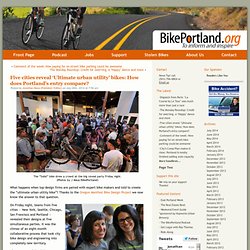
(Photos by J Maus/BikePortland) What happens when top design firms are paired with expert bike makers and told to create the “ultimate urban utility bike”? Welcome to the World of Electric Bikes. ProdecoTech Stride 500 electric bike.

If you are new to electric bikes then this article will help you get a quick understanding of what electric bikes are all about. You will learn about; the reasons to have an e-bike,how fast and how far they go,how much they cost, the different types of e-bikes,what the future of e-bike looks like,and how to checkout electric bikes in your town/city. So what’s the point of an electric bike? Complete Street Design and Good Examples. Strasbourg, France is a beautiful city that takes its complete streets to heart. The roads through the old (and new) city gracefully mix street trams/lightrail with bicycle paths and friendly traffic calmed streets. Pedestrians move easily. The urban mobility portal - Show video - Graz: Pedelec testing for senior citizens in Graz.
How ‘zero’ became the biggest number in road safety. New York City leaders have begun implementing a Vision Zero policy in the city, which has helped to create separated bike lanes and greater traffic speed enforcement to decrease road fatalities. Photo by the New York City Department of Transportation/Flickr. According to the World Health Organization’s (WHO) Global status report on road safety 2013, only 7% of the world’s population is governed by comprehensive road safety laws. In a world that already sees 1.24 million deaths from traffic crashes each year and increasing motor vehicle usage, this is a frightening prospect and limits our thinking on traffic safety to driver behavior.
Countries like Sweden, however, have taken ambitious, holistic steps to improve traffic safety and save lives through an initiative called Vision Zero, a road safety framework that asserts that “no loss of life is morally acceptable.” New BRT data shows cities’ increased commitment to sustainable transport. Bus rapid transit (BRT) is expanding worldwide, particularly in Asia and Latin America. Watch it grow on BRTdata.org. Photo by EMBARQ Brasil. The BRTData.org global database of bus rapid transit (BRT) data has recently been updated, and the increased number of BRT lines, as well as the length of those lines, reflects the commitment of cities around the world to provide high-capacity mass transport to their citizens.
Cycling Gets "Chic" for Everyone. Survey Says: Electric Bikes Enable More People to Ride Bikes, More Often! TRL549. SHRP2_PB_C16. Ehp.1307250. Identifying and Overcoming Barriers to the Implementation of Active Transportation Policies. This research paper investigates the implementation of Ontario’s provincial and municipal policies that seek to build communities that encourage walking and cycling. Although policies have recently come a long way in recognizing and promoting active transportation, aligning policy is different than aligning practice, and current policies are not necessarily translating into successful on-the-ground implementation. The paper explores the institutional barriers that exist in detailed planning, development, engineering, and construction process that have not caught up with higher-level policies including engineering standards and other institutionalized practices.
Overall, the research found that despite high level policies that encourage active transportation, institutionalized barriers continue to exist that promote roadway design primarily oriented toward accommodating motor vehicles. Project Reports. The Fundamental Law of Road Congestion: Evidence from US cities. NBER Working Paper No. 15376Issued in September 2009NBER Program(s): EEE.
Cycling. Seeing business upsides, Old Town retailers propose protected bike lanes on 2... [1407.1031] The Shortest Path to Happiness: Recommending Beautiful, Quiet, an... Cities for People - Collaborative experiments in making cities better. CEUM - Get2gether Neighborhood Challenge (english) Get Local Map. Transportation 2014. Transportation in Canada: Transforming the Fabric of our Land will highlight some of the major components in the development of Canadian transportation over the past century, and their impact on the lives of Canadians. Available as a free download above, this commemorative, 12 chapter online book will feature archival images and interesting perspectives about transportation’s past, present and future. Each chapter is written by a guest author widely acknowledged as a subject matter expert. Directory. Bike Train Ontario. Add Your Footprints to the Walking Movement. Community Commons has partnered with Kaiser Permanente and the Every Body Walk!
Campaign to spread the message that walking a total of 30 minutes a day, five days a week really can improve your overall health and prevent disease. Toronto Centre for Active Transportation. The Toronto Centre for Active Transportation (TCAT) is holding its 7th annual active transportation policy conference - the Complete Streets Forum - on October 6, 2014 in Toronto. The Complete Streets Forum is an influential event that brings together hundreds of professionals, decision-makers and community members from the Greater Golden Horseshoe and beyond. Each year, exit surveys show a high satisfaction rate and interest in attending future events. Ntact. Blackspire. Pedal Installation and Removal. Installing and Removing Pedals. The Recumbent Bicycle and Human Powered Vehicle Information Center.